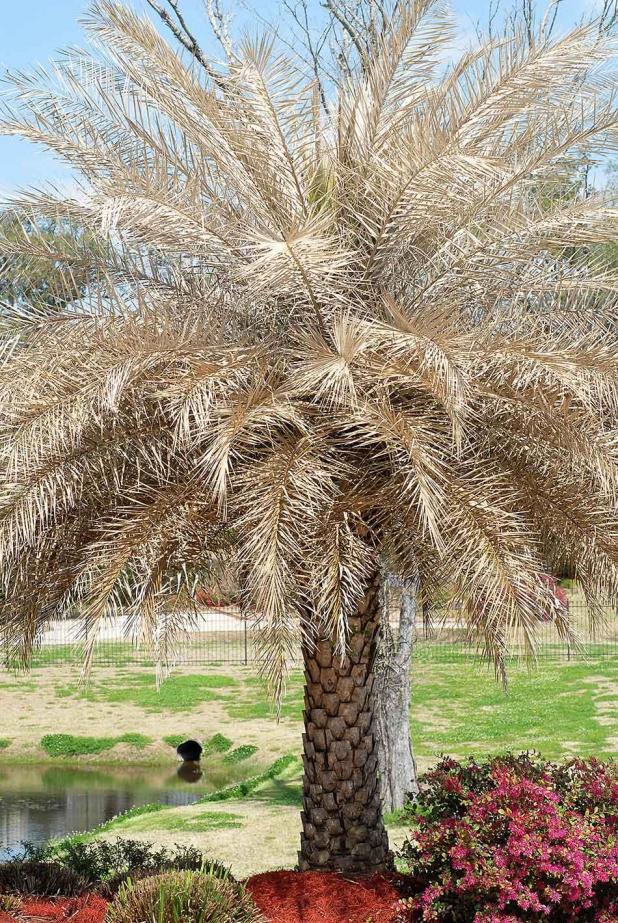
A silver palm damaged from a hard freeze.
LSU AgCenter/Raj Singh
Get It Growing: Caring for freeze-damaged palms
The winter weather that the Bayou State experienced the week of Mardi Gras severely damaged many of our plants. You may have thought your palm trees escaped the cold without too much damage, only to notice freeze injury begin to show up a week or 10 days later.
This delayed onset of outward signs of cold damage is typical for palms. If you’re now wondering what to do with a freeze-damaged palm, it’s important to first take a moment to understand how these plants work and the different types of injury they can sustain in low temperatures.
Twenty-one species of palms are known to exist in Louisiana. They’re native to tropical and subtropical climates, although two common species grown here — the cabbage palm and the Chinese windmill palm — are relatively cold tolerant. Some cabbage and windmill palms were still damaged in our recent freeze, but not as severely as Canary Island date palms, edible date palms, queen palms and silver date palms.
Palms are monocots, or grass-like flowering plants. Their trunks, or stems, have a central growing point called an apical meristem — also known as a bud or heart — from which all new fronds emerge. If for some reason this central growing point gets killed, the palm will die. This can happen even to fully grown, well-established palms.
Wrapping a palm trunk in burlap or a frost protection blanket to prevent cold damage does not protect the apical meristem.
Before you start caring for freeze-injured palms, you need to figure out what kind of injury has occurred. There are three types.
First, chilling injury from temperatures above freezing results in browning of leaves commonly known as necrosis, or death, of the palm fronds. Chilling injury results from a sudden drop in the temperatures in the 40-to-45-degree range. This type of injury is not deadly, and affected palms recover fully from the damage.
The second type of injury is frost injury that occurs when the leaf temperature drops to 32 degrees or below. The damage is similar to chilling injury, but affected palms may take longer — a year or more — to fully recover.
The third and deadly type of injury results from hard freeze. Extended temperatures below freezing not only affect the exposed fronds, but may also kill the base of the spear leaf (newest leaf in the palm canopy) in the apical meristem. This dead tissue is subsequently colonized by decomposing fungi and bacteria, resulting in the death of the meristem.
Severe freezing temperatures may also kill the apical meristem. The spear leaf turns brown and can easily be pulled from within the palm canopy. Once the meristem of the palm is dead, it will not produce another one.
Freezing temperatures also can cause the stems of some species, including queen and silver palms, to split longitudinally. These splits are later colonized by decomposing organisms, resulting in softening of the stem. As the decomposition progresses, vascular tissue rots, interrupting the water and nutrient supply. In some instances, palms break in the middle at the affected area.
When it comes to caring for freeze-injured palms, be patient. Do not rush into removing the affected (brown) fronds immediately after the damage becomes visible. If a portion of a frond is still green, leave it on the plant as long as possible. It may look unsightly, but it will benefit the palm during the recovering phase. The green portion will aid in photosynthesis necessary for production of sugars to support growth.
Palms usually start their growing season long after other shrubs and trees begin their spring growth flushes. Wait for the affected palm to produce new growth, and do not remove the affected fronds until the danger of additional hard freezes is over.
Affected palms should not be irrigated or fertilized now. Fertilize palms during the active growing season from as early as late spring to early fall. Water palms adequately to avoid any drought stress, especially during summer months.
If a cold-damaged palm does not produce new growth and has to be replaced, plan to plant a new one in early summer. Root growth in Louisiana is best in June, July and August, and new palms will also benefit from annual fertilization in early summer. When selecting new palms, think about cold-hardy species, including cabbage and windmill palms.
